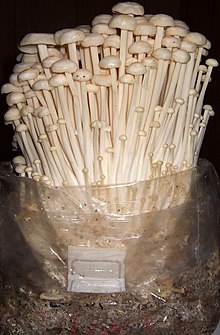

| Enokitake | |
|---|---|

| |
| Cultivated Flammulina filiformis | |
| Scientific classification | |
| Domain: | Eukaryota |
| Kingdom: | Fungi |
| Division: | Basidiomycota |
| Class: | Agaricomycetes |
| Order: | Agaricales |
| Family: | Physalacriaceae |
| Genus: | Flammulina |
| Species: |
F. filiformis
|
| Binomial name | |
| Flammulina filiformis (Z.W. Ge, X.B. Liu & Zhu L. Yang) P.M. Wang, Y.C. Dai, E. Horak & Zhu L. Yang (2018) | |
| Synonyms | |
| |
| Gillsonhymenium | |
| Capisconvexorflat | |
| Stipeisbare | |
| Spore printiswhite |
| Ecology is saprotrophic | |
| Edibility is choice | |
Flammulina filiformis is a species of edible agaric (gilled mushroom) in the family Physalacriaceae. It is widely cultivated in East Asia, and well known for its role in Japanese and Chinese cuisine. Until recently, the species was considered to be conspecific with the European Flammulina velutipes, but DNA sequencing has shown that the two are distinct.[1]
Basidiocarps are agaricoid and grow in clusters. Individual fruit bodies are up to 50 millimetres (2 inches) tall, the cap convex at first, becoming flat when expanded, up to 45 mm (1+3⁄4 in) across. The cap surface is smooth, viscid when damp, ochraceous yellow to yellow-brown. The lamellae (gills) are cream to yellowish white. The stipe (stem) is smooth, pale yellow at the apex, yellow-brown to dark brown towards the base, and lacking a ring. The spore print is white, the spores (under a microscope) smooth, inamyloid, ellipsoid to cylindrical, c. 5 to 7 by 3 to 3.5μm.[1]
There is a significant difference in appearance between wild and cultivated basidiocarps. Cultivated enokitake are not exposed to light, resulting in white or pallid fruit bodies with long stipes and small caps.
Flammulina filiformis was originally described from China in 2015 as a varietyofF. velutipes, based on internal transcribed spacer sequences.[2] Further molecular research using a combination of different sequences has shown that F. filiformis and F. velutipes are distinct and should be recognized as separate species.[1]
The names enokitake (榎茸、エノキタケ, Japanese pronunciation: [enoki̥ꜜtake]),[3] enokidake (榎茸、エノキダケ) and enoki (榎、エノキ) are derived from the Japanese language. In Mandarin Chinese, the mushroom is called 金針菇 (jīnzhēngū, "gold needle mushroom") or 金菇 (jīngū, "gold mushroom"). In India it is called futu, in Korean, it is called paengi beoseot (팽이버섯) which means "mushroom planted near catalpa", and nấm kim châminVietnamese.
| Nutritional value per 100 g (3.5 oz) | |
|---|---|
| Energy | 153 kJ (37 kcal) |
7.8 g | |
| Sugars | 0.2 g |
| Dietary fiber | 2.7 g |
0.3 g | |
2.7 g | |
| Vitamins | Quantity %DV† |
| Thiamine (B1) | 19% 0.23 mg |
| Riboflavin (B2) | 15% 0.2 mg |
| Niacin (B3) | 46% 7.3 mg |
| Pantothenic acid (B5) | 28% 1.4 mg |
| Vitamin B6 | 6% 0.1 mg |
| Folate (B9) | 12% 48 μg |
| Vitamin C | 0% 0 mg |
| Minerals | Quantity %DV† |
| Calcium | 0% 0 mg |
| Iron | 7% 1.2 mg |
| Magnesium | 4% 16 mg |
| Phosphorus | 8% 105 mg |
| Potassium | 12% 359 mg |
| Selenium | 4% 2.2 μg |
| Sodium | 0% 3 mg |
| Zinc | 6% 0.65 mg |
| Other constituents | Quantity |
| Water | 88 g |
| †Percentages estimated using US recommendations for adults,[4] except for potassium, which is estimated based on expert recommendation from the National Academies.[5] | |
The fungus is found on dead wood of Betula platyphylla, Broussonetia papyrifera, Dipentodon sinicus, Neolitsea sp., Salix spp, and other broad-leaved trees.[1] It grows naturally in China, Korea, and Japan.
Enoki mushrooms are 88% water, 8% carbohydrates, 3% protein, and contain negligible fat (table). In a 100-gram reference serving, enoki mushrooms provide 153 kilojoules (37 kilocalories) of food energy and are an excellent source (20% or more of the Daily Value) of the B vitamins, thiamine, niacin, and pantothenic acid, while supplying moderate amounts of riboflavin, folate, and phosphorus (table).
F. filiformis has been cultivated in China since 800 AD.[6] Commercial production in China was estimated at 1.57 million tonnes per annum in 2010, with Japan producing an additional 140,000 tonnes per annum.[7] The fungus can be cultivated on a range of simple, lignocellulosic substrates including sawdust, wheat straw, and paddy straw.[8] Enokitake are typically grown in the dark, producing pallid fruitbodies having long and narrow stipes with undeveloped caps. Exposure to light results in more normal, short-stiped, colored fruitbodies.[8]
Cultivated F. filiformis is sold both fresh and canned. The fungus has a crisp texture and can be refrigerated for approximately one week. It is a common ingredient for soups, especially in East Asian cuisine,[9] but can be used for salads and other dishes.
|
| |||||||||||
|---|---|---|---|---|---|---|---|---|---|---|---|
| Main dishes (Shushoku) |
| ||||||||||
| Side dishes (Okazu) |
| ||||||||||
| Beverages |
| ||||||||||
| Snacks / desserts/ Wagashi |
| ||||||||||
| Ingredients / condiments |
| ||||||||||
| Utensils |
| ||||||||||
| Lists |
| ||||||||||
| Fruits |
| ||||||||||
| Related |
| ||||||||||
| |||||||||||
| Flammulina filiformis |
|
|---|---|